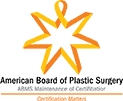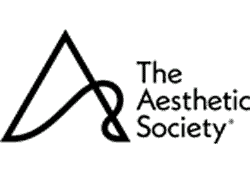Advanced Nasal Reconstruction and Functional Restoration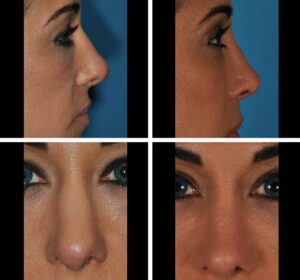
Secondary and tertiary rhinoplasty are highly specialized procedures performed to correct functional deficits, aesthetic irregularities, or structural deformities following one or more prior nasal surgeries. Unlike primary rhinoplasty, these operations require a detailed understanding of altered anatomy, scar contracture, and the potential absence of reliable septal support.
Dr. Ali Totonchi is a board-certified plastic surgeon renowned for his expertise in primary and revision rhinoplasty. He lectures nationally and internationally on this topic and has written multiple textbook chapters and articles. Additionally, Dr. Totonchi serves on the board of directors for The Rhinoplasty Society (TRS), combining surgical precision with an artistic understanding of facial harmony. With extensive training in both aesthetic and reconstructive nasal surgery, Dr. Totonchi is recognized for achieving natural, balanced results that enhance both form and function. A significant portion of Dr. Totonchi’s practice involves revision rhinoplasty, managing challenging cases of structural collapse, asymmetry, and airway compromise following prior nasal surgery.
Indications for Revision Surgery
Patients may present with one or more of the following:
- Persistent or worsened functional obstruction (e.g., nasal valve collapse, septal deviation, turbinate dysfunction).
- Aesthetic deformities such as asymmetry, tip irregularity, pollybeak deformity, dorsal irregularities, or over-resection/under-resection of cartilage.
- Structural deficiencies including loss of dorsal support, saddle nose deformity, or tip collapse.
- Unsatisfactory prior outcomes either from technical limitations or postoperative healing variables.
Unique Challenges of Secondary/Tertiary Rhinoplasty
 Revision surgery involves working in a scarred operative field with distorted or absent anatomical landmarks. Specific challenges include:
Revision surgery involves working in a scarred operative field with distorted or absent anatomical landmarks. Specific challenges include:
- Cartilage deficiency: Septal cartilage is often unavailable, necessitating autologous grafts from auricular (ear) or costal (rib) cartilage.
- Scar contracture: Dense fibrosis can obscure tissue planes, increasing dissection difficulty and risk.
- Soft tissue contracture
- Airway preservation: Ensuring functional patency of the internal and external nasal valves while achieving aesthetic goals.
- Complex reconstructive demands: Often requiring structural grafting, spreader grafts, columellar struts, and dorsal reconstruction.
- Lack of septum as cartilage source
- Emotional and psychological challenges
Surgical Philosophy & Approach
Over the course of his career, Dr. Totonchi has refined advanced rhinoplasty techniques to address complex nasal anatomy, breathing issues, and aesthetic concerns. His meticulous approach focuses on preserving nasal structure and function while enhancing each patient’s unique features. As a specialist in revision rhinoplasty, Dr. Totonchi is often sought by patients who have undergone prior nasal surgery and desire restoration of both appearance and airway integrity.
With Dr. Totonchi, revision rhinoplasty is approached with the principles of reconstruction, restoration, and refinement:
- Comprehensive analysis using clinical photography, airway evaluation, and in select cases, imaging to assess structural deficits.
- Structural grafting techniques (septal, auricular, or costal cartilage) to restore integrity, support, and contour.
- Precise sculpting and camouflage techniques to address surface irregularities while maintaining long-term stability.
- Balance of form and function, ensuring both aesthetic harmony and reliable nasal airflow.
- In severe cases, on top of cartilage grafts like rib, ear, and donor grafts, soft tissue transfer might be necessary to achieve our goals
Patient Selection and Timing
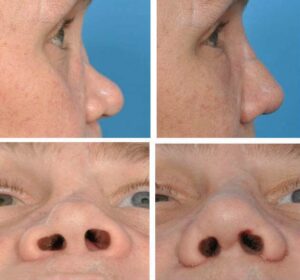 Secondary or Tertiary rhinoplasty is typically considered after 12–18 months from the prior surgery, allowing scar tissue to mature and nasal structures to stabilize. Ideal candidates are those with:
Secondary or Tertiary rhinoplasty is typically considered after 12–18 months from the prior surgery, allowing scar tissue to mature and nasal structures to stabilize. Ideal candidates are those with:
- Realistic expectations about the degree of improvement achievable.
- Stable medical health for elective surgery.
- Motivation for both functional correction and aesthetic refinement.
Consultation and Planning
Dr. Totonchi’s philosophy centers on customized treatment planning, clear communication, and compassionate care. He takes time to understand each patient’s goals and develops a tailored surgical plan to achieve lasting, refined, and natural-looking results.
During consultations, a thorough discussion of prior surgical history, functional symptoms, and aesthetic concerns is conducted. Surgical planning incorporates realistic outcome assessment, with emphasis on setting achievable goals and minimizing risk in a previously operated field.
Recovery and Results
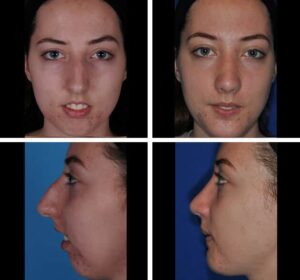 A splint will be placed outside the patient’s nose to help support the new shape as the nose heals. In the case of septoplasty, or straightening of the nasal septum, Dr Totonchi, will use nasal stents inside the nose which are removed 2 weeks after surgery. You should expect your incisions to heal after approximately 1-2 weeks. The swelling and bruising will remain for a few weeks after the procedure. Do not be alarmed if the swelling comes and goes during recovery, this is completely normal. You may be required to tape your nose to minimize swelling and promote healing after the stent is removed.
A splint will be placed outside the patient’s nose to help support the new shape as the nose heals. In the case of septoplasty, or straightening of the nasal septum, Dr Totonchi, will use nasal stents inside the nose which are removed 2 weeks after surgery. You should expect your incisions to heal after approximately 1-2 weeks. The swelling and bruising will remain for a few weeks after the procedure. Do not be alarmed if the swelling comes and goes during recovery, this is completely normal. You may be required to tape your nose to minimize swelling and promote healing after the stent is removed.
Once the swelling subsides, you will begin to see your new nose contours define and develop. Your new nasal contours will fully refine about a year or two after your rhinoplasty. Each patient will have post-operative appointments throughout the recovery to ensure proper healing.
Dr. Totonchi serves patients from across the country and beyond at Totonchi Plastic Surgery in Lyndhurst, Ohio, where he offers advanced surgical techniques. His dedication to excellence, precision, and patient satisfaction has established him as a leading authority in the field of rhinoplasty and revision nasal surgery. Please call 440-461-7999 to schedule your consultation today!






